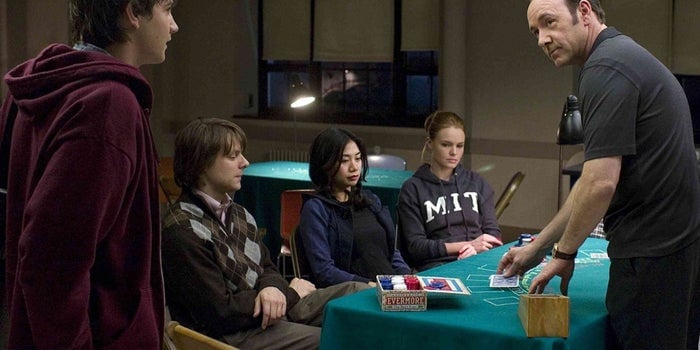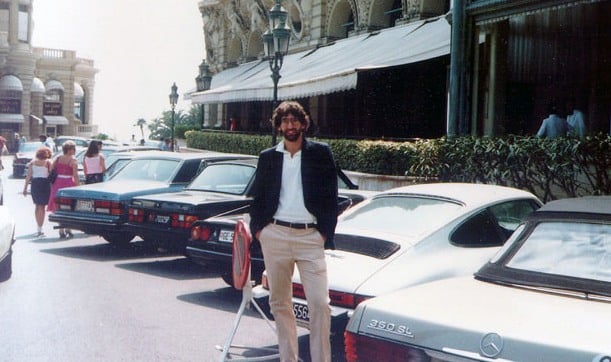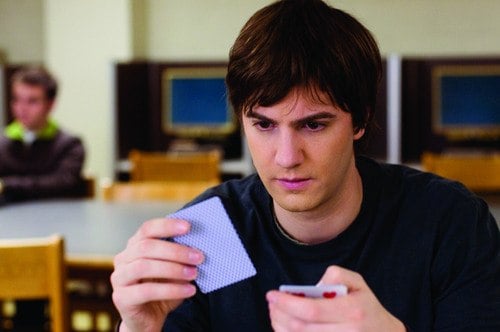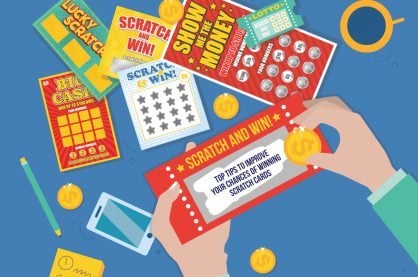How The MIT Blackjack Card Counting Team Beat The House
It’s one of the oldest clichés in the world of casinos: The house always wins.
Except it doesn’t.
For more than a decade, a team of card counters based around the Massachusetts Institute of Technology (MIT) proved that the house could be beaten.

They came up with, and put into practice, a method for winning at blackjack.
The idea came from the studies of Edward Thorp, a math professor at MIT, who devised a card counting system in the 1950s using the earliest computers.
The team’s success inspired a 2008 movie, 21, starring Kevin Spacey (above), and a best-selling book Bringing Down The House.
But who were these guys? How did they do it? And could their methods still work today?
The MIT Blackjack Card Counting Technique
The first thing to make clear is that card counting is not actually illegal – as long as you are counting in your head. It is a form of advantage play.
Nevada state laws, for instance, specifically prohibit card counting using electronic or mechanical aids.
However, legal though it may be, it’s fair to say that you won’t win many friends among casino owners if you practise the art successfully.
The simplest way of describing the “Hi-Lo” method used by the MIT blackjack card counting team is as follows. You count the high and low cards that have been played since the last shuffle.
You’ll need to have memorized a value assigned to all cards in a deck:
- High cards (10, Jack, Queen, King and ace) count as -1
- Low cards (2, 3, 4, 5 and 6) count as +1
- The rest count as 0
If it becomes clear as the game progresses that the cards dealt out have an overall positive value, that’s the time to bet big.
Mike Aponte, one of the leading members of the MIT team, offers a simple guide to card counting on this video:
Who Were The MIT Team?
The team came together at the start of the 1980s. A group of students at MIT taught themselves a card-counting technique and went to Atlantic City to try it out.
One of the team, JP Massar, overheard a conversation in a Chinese restaurant in Cambridge, where MIT is based.
The man talking was Bill Kaplan (below), who had graduated three years earlier but put off going to Harvard Business School so that he could try to become a professional gambler.
He was talking about how he had run a successful blackjack team in Las Vegas in 1977. He had gone there with $1,000 and turned it into $35,000.
Now Kaplan trained and managed a new team, run as a business with formal management procedures and stringent player selection.
Many MIT students tried out for the team – some were accepted. A ten-strong team rolled into action with an $89,000 investment in August 1980 and in 10 weeks they had doubled their money.

What Was Their Strategy?
Players were recruited through fliers and word of mouth. Potential members were thoroughly vetted.
The process included a “trial by fire”, in which you had to play through eight six-deck shoes with almost perfect results.
As the system kept paying off, the team kept growing. By 1984 there were 35 players and during the 1980s more than 70 different people played in some capacity.
Every partnership set up by the team – there were at least 22 – was profitable. Annual dividends to investors were between 4% and more than 300%.
The team set up a company, Strategic Investments, in 1992 with investment of $1million.
By now they were using a strategy with a three-person team – a big player, a controller and a spotter.
The spotter would check when the deck “went positive”, while the controller was there to bet small and double-check the spotter’s counting. When the count was verified, a signal would be made to the big player, who would make a huge bet – often with huge returns.
Over the next two years the team grew to nearly 80. There were groups in Cambridge, New York, New Jersey, Pennsylvania, California, Illinois and Washington.
At times the team had up to 30 members playing simultaneously at casinos around the world.
Kaplan said: “There are tens of thousands of people who tried to win at the game, but MIT was the only team who really won year over year, because we ran it like a business.
“Training, extensive training, checkout procedures, two hours of perfect play, leaving the table right. It was really run more tightly than most businesses.”

They Carried On Until They Got Caught
Gradually, the bosses realized there was an organized and specific campaign going on. A private detective worked out from the addresses of some involved that there was a connection with Cambridge.
Several of the more prominent team members were identified and banned from casinos. At the end of 1993, Strategic Investments paid out earnings to players and investors and dissolved their partnership.
Casinos also became more adept at spotting card counters and shuffling the decks more often – as many online casinos do today.
As soon as a deck is shuffled, a card counter has to go back to zero and the edge is lost.
How Much Money Did The MIT Blackjack Team Make?
It’s impossible to say.
Card counting is not a foolproof system, but implemented correctly it can give you an edge of between 2% and 4% over the house.
Some have claimed that total winnings for the team were in excess of $10million, but that’s impossible to verify.
Mike Aponte reckons the biggest win was about $500,000 on Super Bowl weekend in 1995. Meanwhile, the largest loss was $130,000.
…Where Are They Now?
Some team members carried on after Strategic Investments folded. They tried more sophisticated systems and were more careful with their recruitment. But by 2000 virtually all had drifted away from blackjack.
Bill Kaplan, the man who started it all, realized that he would have less hassle, and possibly more profit, investing in property and business.
John Chang, another prolific member of the MIT card counting team, still visits casinos. He often wears disguise so members of the public don’t recognize him.
Here he is talking about the movie 21 and card counting in general:
Practice Makes Perfect
By now it should be clear that card counting can work – but it takes time, practice, nerves of steel and a big bank.
You can practice with a card counting trainer tool. This will teach you the basics of assigning values to all cards and working out what the overall value of the dealt cards is as play progresses.
There are even more advanced strategies that give more variation in the value ascribed to particular cards.
Once you’ve mastered the basics, though, it’s all about practice – and more practice – so that you can try the technique in a live scenario.
Be wary about using it in an online blackjack game, though – cards tend to be shuffled far more often than in a casino.
If you enjoyed this post, be sure to read this amazing story about a professor who beat the roulette wheel. He made MILLIONS!
Sources:
https://en.wikipedia.org/wiki/MIT_Blackjack_Team
https://www.bbc.co.uk/news/magazine-27519748
https://www.bostonmagazine.com/arts-entertainment/2019/06/21/mit-blackjack-team/
http://www.historyvshollywood.com/reelfaces/21mitblackjack.php


